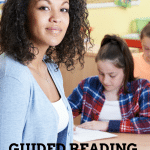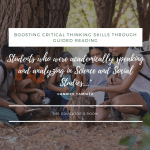Guided reading is a teaching strategy that has gained attention and popularity over the past ten years for good reason. This method of teaching reading (to elementary students) groups them according to their instructional text reading level. It incorporates skills, comprehension strategies, writing, and text decoding. There are many companies with canned programs and resources you can purchase to lead a guided reading group. If this is a new strategy for you, the first thing you should read is Good First Reading by Fountas and Pinnell. This book gives you strategies and technique to set up your classroom for guided reading and explains the entire process.
Guided reading requires the teacher to have at least three or four small groups daily. Overwhelming? Yes it can be. I have found a system and some standard questions I like to use with any fiction book. Here are some tips from five years implementation in the upper elementary levels.
I like to use my lesson time in discussion with students. I usually have 25 minute groups and spend 20 minutes in discussion and activity from the reading the day before. I then give students 5-10 minutes to read at the table and they finish the reading on their own. Select one student a day to do a timed reading on. This will give you information about their decoding strategies and fluency. I also review vocabulary every day. I teach students to tag words they are unfamiliar with. We write those words down and look for prefixes and suffixes as well as chunks. We talk about what we know about the words and use the context to try and find meaning. If students are still unable to create a picture of the word or use it in a conversation we look the words up in dictionaries or on the i Pads. This is ongoing each day during our lesson.
Day 1—Start the lesson by pulling the major theme or setting from the book. Tell students the title of the new book. Ask them to write or draw pictures for about five minutes about everything they know about this theme or setting. This allows you to learn their prior knowledge and any misconceptions they may have. Talk about what they wrote and correct any misconceptions. During the reading (usually three to four chapters daily depending on their length) I have students keep a chart of the major characters and setting. They need to write characteristics, personality traits, and general descriptions found in the book. Be sure to ask students to write page numbers that refer to where the information is supported in the text. This will enable smoother discussion the next day.
Day 2 and 3—Discuss the character traits and setting clues students found during their reading the day before. Have them refer back to the pages with their evidence. Ask the group to find each page, have a volunteer read the text that supports their ideas. Discuss what others think. Referring back to the book to support their ideas is the important skill during day two. Assign the next set of chapters (three or four) and pick one of these skills to focus on depending on what can be found in these chapters. If students need further practice do the same skill for two days, otherwise do one skill each day.
- Figurative Language – (metaphors, similes, description, or idioms ) Explain and define the term you are focusing on and have students cite examples in their reading. Remember to include page numbers for discussion.
- Comprehension Strategies—(using prior knowledge, visualizing, making connections to self, text, world, questioning, inferring, summarizing, evaluating, synthesizing) Into the Book is an excellent web site for teachers and students. This site provides explanations of the strategies and practice for kids. Explain and define the strategy you are focusing on and have students do an activity to practice the strategy. They can use pictures to show visualizations or create an image to summarize a chapter. They can write questions or connects they make as they read. They can use graphic organizers to practice the skills.
- Literary Skills—(parts of speech, writing traits, author’s purpose, text structure, point of view) Explain and define the skill you are focusing on and have students do an activity to practice the skill. Whatever you do, have them refer back to the book and include the page number for discussion.
Day 4—Discuss the activity from the day before. Have them refer back to the pages with their evidence. Again, ask the group to find each page and have someone read. This is a great time for teaching moments and to discuss misconceptions of the skill or strategy you are focusing on. Assign the next set of chapters. During this set I like to have students find their original chart of characters and setting. Using a colored pencil, students should write characteristics, personality traits, and general descriptions found in the book. They should be focusing on changes the characters may be going through. Be sure to ask them to write page numbers that refer to where the information is supported in the text.
Day 5—Discuss how the characters have changed. Students can make a Venn diagram or a triple chart to show a character at the beginning of the book, how the character remained the same, and the character at the middle or end of the book. The same character should be described on the chart, not two different characters. It is about visualizing the change that has occurred. The discussion today is about theme. Discuss theme with students and talk about what the theme of the book may be. This is a harder skill for elementary kids. You may need to give them some choices to decide what the theme is. As students are reading the next set of chapters they should write down pages that have evidence that support their idea of the theme.
Day 6— Discuss theme and the evidence they had to support their idea. Assign the next set of chapters and give students a focus from summarizing including problem solution or conflict. They should include evidence in a T chart for the problem and resolutions or conflict in story: character vs character, character vs self, character vs society, character vs nature.
Day 7—Discuss what has happened in the story so far. Talk about major characters and how they have changed, the setting, problem and solution. This is also a good day to talk about conflict in story: character vs character, character vs self, character vs society, character vs nature. You can have students draw a plot diagram, rewrite chapter titles to reflect the main idea of each chapter, or draw a new cover for the book. Assign the next set of chapters. This is often the last day of the book, so I allow students to finish reading without a focus. If you have another day you need to finish, select an activity from the previous days that students need more practice with. You can also have them continue their list on their characters to show change.
Day 8—Today have students do an activity to evaluate or synthesize the book. Depending on the length of the activity this may take two days. You can find activities online or pick from my limited list below. Think of ways students can represent the book. When we read From the Mixed up Files of Basil E Frankweiler I had students tape a piece of paper to the underside of the table and draw their favorite scene. This gave them a glimpse of painting the ceiling. Be creative and have fun.
Suggested Activities:
- Write questions to your favorite character. They must be higher level questions from analysis, synthesis, and evaluation. Use Bloom’s Taxonomy for stems.
- Write questions to the author. They must be higher level questions from analysis, synthesis, and evaluation. Use Bloom’s Taxonomy for stems.
- Compare one of the characters to yourself. Use a Venn diagram. Think about personality, characteristics, the problem they went through in the book, their setting, etc.
- Create a timeline of the major events in the story.
- Make a game about the book.
- Rewrite the ending of the book and change the outcome.
- Write the beginning of a sequel to the book. How could the first chapter start?
Guided reading allows you to teach students at their instructional level. The important thing is to cover your state standards and use higher level thinking skills as students work through the book. The discussion from the students is often the most meaningful part of the lesson. Be creative and enjoy reading!






Leave a comment